The saying goes: “Give a man a fish, and he’ll eat for a day. Teach a man to fish, and he’ll eat for a lifetime.” But teach a man the science of fish, and we all benefit.
Every year more than 100 graduate students come to the University of Maryland Center for Environmental Science to work side-by-side with some of the best environmental scientists in the world. Studying everything from the effects of development on stream ecosystems to new ways to feed fish in aquaculture, these men and women are training to solve environmental problems today so we have a better world tomorrow.
AARON WATSON
Importance of taurine in vegetarian fish diets
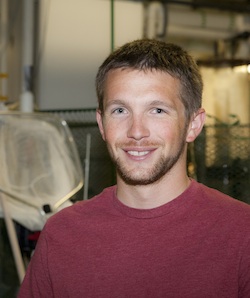 Faced with overfishing of our oceans and the pollution of fish by PCBS and mercury, aquaculture is rising as a commerically viable and healthy food alternative. But how do you farm predatory fish such as cobia and sea bream without feeding them more fish? Aaron Watson has been experimenting with vegetarian fish diets to find out.
Faced with overfishing of our oceans and the pollution of fish by PCBS and mercury, aquaculture is rising as a commerically viable and healthy food alternative. But how do you farm predatory fish such as cobia and sea bream without feeding them more fish? Aaron Watson has been experimenting with vegetarian fish diets to find out.
"The human population is expanding and protein demand is expanding, and that necessitates aquaculture to expand," said Watson. "We've maxed out on fish oil and fish meal production and need to find alternatives."
Watson has been working with advisor Dr. Allen Place at the Institute of Marine and Environmental Technology to develop a vegetarian diet for fish that includes proteins and algae instead of fish meal. He has helped prove that taurine--an amino acide found in energy drinks and used by body builders--is essential for fish to grow on a vegetarian diet.
JAKE GOODWIN
Identifying bivalve larvae with polarized light
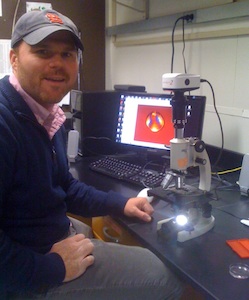 The rainbow of colors and swirling patterns may look like something out of a psychedelic art show, but the images Jake Goodwin sees on his computer screen give up the secrets of the eastern oyster's identity.
The rainbow of colors and swirling patterns may look like something out of a psychedelic art show, but the images Jake Goodwin sees on his computer screen give up the secrets of the eastern oyster's identity.
It has long been difficult for scientists to tell the difference between larvae of bivalves such as oysters, clams, and mussells. Goodwin is working with advisor Dr. Elizabeth North in the Horn Point Laboratory to test a novel technique that uses polarized light to help make the identification.
"When you shine polarized light on bivale shells they emit species-specific patterns," the said. "Then you can use pattern recognition softare, silmilar to facial recognition software used by the FBI, to classify bivalves. You can achieve accuries int he 90% range."
he has been growing bivalves in different conditions--looking at how food, temperature, salinity, and water densisites affect the analysis technique--to test its precision and accuracy. He hopes to combne his scientific methods one day wth a degree in environmental policy to help make good environmental decisions for the betterment of the public.
REBECCA FOX
Nitrous oxide and methane emissions from agricultural areas
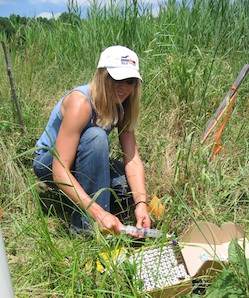 A common practice to reduce agricultural nitrogen from entereing our waterways is to conserve or restore wetlands and create vegetated buffers that protect water resourcces from pollution. These management practices create conditions conducive for denitrification, the prcess by which nitrate is converted to nitrogen gas, which makes up 78% of our atmosphere.
A common practice to reduce agricultural nitrogen from entereing our waterways is to conserve or restore wetlands and create vegetated buffers that protect water resourcces from pollution. These management practices create conditions conducive for denitrification, the prcess by which nitrate is converted to nitrogen gas, which makes up 78% of our atmosphere.
Otherwise, the nitrate leaches into the groundwater and travels with the water to streams, surface water bodies, and eventually to the ocean. Rebecca Fox has been working with her advisor, Dr. Thomas Fisher at the Horn Point Laboratory, to find locations where enhanced denitrification is ocurring.
"When we look at watersheds, we can only account for 35-30% of the nitrogen that enters the watershed," said Fox. "The rest of the nitrogen is missing. We hypothesize that it is reduced to nitrogen gas and released into the atmosphere as a result of denitfrification."
Denitrification also prouduces nitrous oxide, which is a highly potent greenhouse gas. Fox has measured high concentrations of this greenhouse gas in groundwater surrounding agridcultural areas.
ROY WEITZELL
Effects of urbanization on stream ecosystems
A recent study found that 70 percent of headwater streams in Baltimore have been buried by development. Roy Weitzell is trying to prevent the same thing from happening elsewhere.
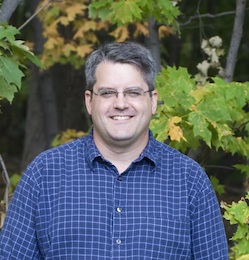
Working with advisor Dr. Andrew Elmore in the Appalachian Laboratory, he is developing methods to model stream burial using remote sensing and geographic information systems (a computer program that allows him to map and analyze data) to see how habitats are connected in headwater streams.
“I’m looking at how much habitat is being destroyed and how it affects the ability of the bugs and fish that live in the water to move around and complete their life history,” said Weitzell. “Bugs have to fly from one stream to another to colonize a new habitat or mate. If those streams are farther away, they might not make it. Fish can’t move through burial areas, so they can’t find refuge or migrate to spawn.”
Since each of the counties in the Potomac River watershed is in control of its own development, Weitzell has been modeling the distribution of stream burial to see how the amounts have changed over time and the policies that impact decisionmaking. The goal is to use this data to help decision makers guide development away from remaining habitat or implement ways to minimize its impact.
CHRIS CONROY
Importance of contingent behavior in juvenile striped bass
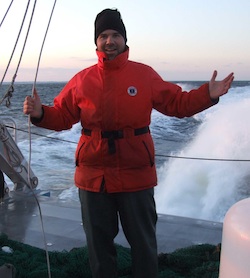 Childhood can have a major impact on any individual, and it turns out to be the same for fish. A movement of just 50 kilometers in the months following hatching can have a lifetime of consequences for striped bass.
Childhood can have a major impact on any individual, and it turns out to be the same for fish. A movement of just 50 kilometers in the months following hatching can have a lifetime of consequences for striped bass.
Chris Conroy has been working with faculty advisor Dr. David Secor in the Chesapeake Biological Laboratory to identify patterns of juvenile migration within natal estuaries using otolith chemistry, or analyzing the growth rings on their earbones.
“We know that juveniles use a range of habitats within these estuaries,” said Conroy. “We’re now trying to determine when these young fish move between these habitats and what spurs them to move.”
When individuals are classified by movement patterns, the resulting groups are called contingents. Differences in growth may lead to the formation of these contingents, and their movements may lead to differences in growth, condition, and even survival. Better understanding of the complex spatial structure of juvenile populations may lead to improved management for the species as a whole.
NAOMI MONTALVO
Bacteria associated with marine sponges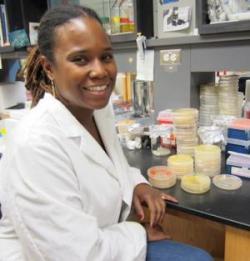
The giant barrel sponge is so large that a scuba diver can fit inside, but man is not its only visitor. Diverse groups of bacteria live there. Naomi Montalvo has been characterizing the bacterial communities that live on two different species of ancient sponges living on different sides of the world to understand the relationship between the microorganisms and their host.
“Marine sponges are the most prolific sources of new pharmaceutical compounds,” said Montalvo. “Sometimes they are produced by sponges or by microganisms living on the sponge. The more we understand about sponges and their communities, the more compounds we can discover. Every time we lose a species of sponge, we lose all of their bacteria and pharmaceutical and ecological potential.”
Working with her advisor Dr. Russell Hill at the Institute of Marine and Environmental Technology, she has been looking at bacteria that can only be found in these sponges to understand the symbiotic relationships, such as whether the bacteria offers a chemical defense against predators and overgrowth, as the first step to unlocking its medical potential.
ADAM PEER
How maternal characteristics in striped bass affect their reproductive process and success
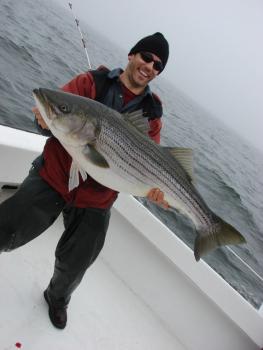 In species like cod, older and larger females produce stronger, larger offspring who may bear a better chance of survival in the ocean. Adam Peer is working with his advisor Dr. Thomas Miller at the Chesapeake Biological Laboratory to see if the same holds true for striped bass.
In species like cod, older and larger females produce stronger, larger offspring who may bear a better chance of survival in the ocean. Adam Peer is working with his advisor Dr. Thomas Miller at the Chesapeake Biological Laboratory to see if the same holds true for striped bass.
“Most fishermen have either a commercial or recreational interest in catching the biggest fish in the population,” said Peer. “We wanted to see if larger females are contributing more offspring, and if so, what kind of impact could this have on the future success of the population.”
After tracking offspring from egg to juvenile in the Patuxent River, his preliminary results show that large females may not necessarily yield more juvenile survivors. Now he’s trying to figure out if this is true on a larger scale—and if so, why.
READ MORE ABOUT THE GRADUATE PROGRAM
